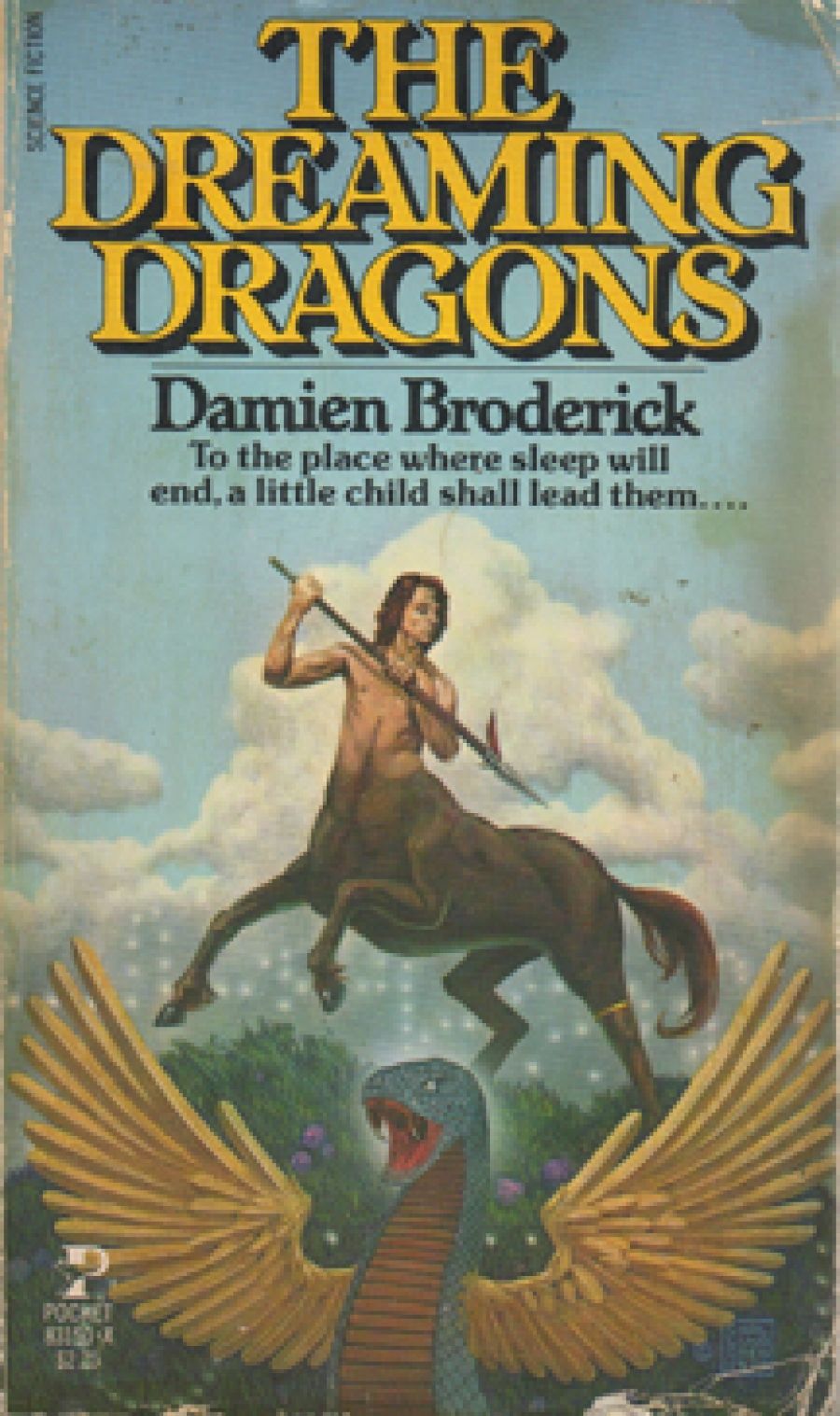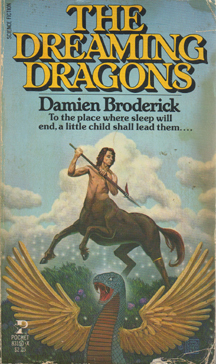
- Free Article: No
- Contents Category: Fiction
- Review Article: Yes
- Article Title: Inside Ayers Rock
- Online Only: No
- Custom Highlight Text:
The epigraph to The Dreaming Dragons suggests that melodrama can accomplish ‘the articulation of the unsayable’.
Accordingly, this book evokes transpersonal consciousness through the medium of a gripping plot, whose effect of conveying ‘the unsayable’ is only heightened by the fact that the writer and his words sometimes seem at odds with one another. Thus, ‘the midday sun took barrenness into its fists and shook it’ is like Roger Zelazny impossibly faltering; and ‘wholly in the dimensions of tactual and haptic space’ involves adjectival tautology. Overall, the writing seems designed to make readers stand back (melodramatically), rather than to lead them into enlightenment.
- Book 1 Title: The Dreaming Dragons
- Book 1 Subtitle: A Time Opera
- Book 1 Biblio: Norstrilia Press, $12.95, 245 p., O 909106 07 X
- Book 1 Cover Small (400 x 600):

- Book 1 Cover (800 x 1200):

The story begins in Australia, a little later than now, when quarks, gluons and tachyons are no longer mere hypotheses of some physicists. A full-blooded Aboriginal anthropologist and his ‘white’ step-nephew (an autistic adolescent) are precipitated into a top-secret military establishment at Ayers Rock, where United States and Soviet personnel are working side by side on what they believe to be an extraterrestrial artefact, which has lain for millions of years almost three kilometres under the Rock. Their investigations have already stimulated them to devise a ‘gluon shield’, which is proof against nuclear or laser bombardment.
Damien Broderick is fully aware of the undeclared war of this era: the military (of all nationalities) versus the rest of the world. Nuclear deterrence being gone, military use of bacterial warfare, with recombinant DNA, is ready. The gluon shields are still impracticable, however, since human beings placed inside them have out-of-the-body experiences, and even go insane; similar, but more pronounced, effects are experienced around the Alien artefact.
Only the autistic adolescent, Mouse, has passed through this defensive field unscathed. He has also brought his uncle through alive, although desperately ill for a time. Mouse’s uncle is Alf Dean Djanyagirnji, who links within himself a tribal awareness of the Dreaming (where Ayers Rock is ‘transvalued’ as ‘Uluru’) and an extensive knowledge of contemporary ‘white’ culture. Alf now dreams of dragons, who attempt to tell him things that he forgets; while Mouse produces, in automatic writing, various human documents, which include the politically explosive diary of a Russian who was used as a guinea-pig for testing a new bacterial weapon.
Why is Mouse affected differently from the others? Is there an Alien still alive underneath the Rock? Is it attempting to communicate helpfully, or are its intentions purely hostile? These are not the only questions posed and answered; we also discover who built the technologically astounding navigational base whose discovery, on the Moon, is being concealed from the public. And we learn why the dinosaurs became suddenly extinct.
Damien Broderick’s book is intensely readable, despite the deficiencies in his style already mentioned. And it is not simple enough to be spoiled (for the new reader) by my revealing a little of the denouement, in order to finish reviewing the book.
The reader learns that humanity’s evolution depended on saurians in a way hitherto undreamed of. The individual human brain is incapable of accommodating the kind of memory and intelligence that people actually display; Jung’s ‘collective unconscious’ is a reality, the mechanism for which is the amplifying device under Ayers Rock (the ‘Soul Core’) in which all intelligent consciousness is registered, and which contains ‘the immortal dead’. Cut off from this (as under the man-made gluon shield) the brain’s operations are puerile. And the Soul Core, which allowed humanity to develop a collective intelligence, was built on this earth by the ‘plumed serpents’, Saurus sapiens, thousands of years in the future.
Thus, The Dreaming Dragons contains a time-paradox which is glossed over. The Soul Core is an artefact made (and ‘peopled’) by beings who hurtled back from the future and accidentally wiped themselves out before they began to evolve; so that the world in which the Core now operates is one where the Core’s creators (and inhabitants) never existed. The words ‘paratime’· and ‘parareality’ fail to obscure this violation of causality; even. tachyons (faster-thanlight particles) would be helpless. to assist.
Nevertheless, The Dreaming Dragons has much more than faults to offer. If, like Mouse’s mind, it is a flawed prism, its rainbow effects are impressive (its renderings of transpersonal consciousness); and Damien Broderick, considered as the light-source, is not feeble, and only rarely fuzzy. It is clear that he really cares to communicate his intensely integrative vision.


Comments powered by CComment